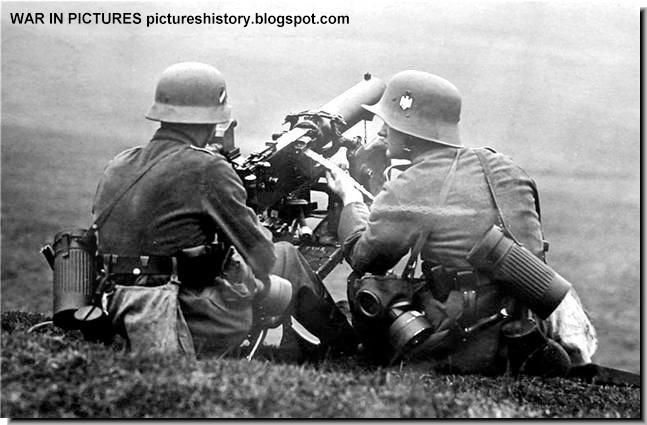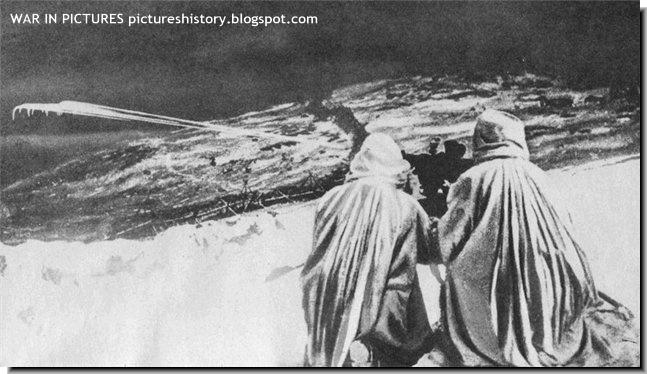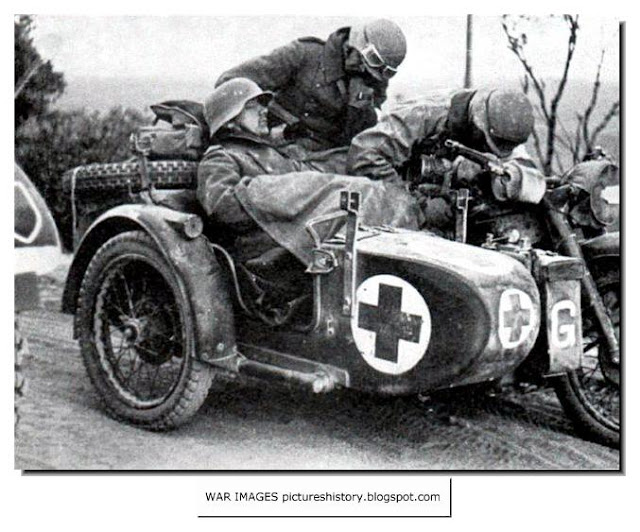Preparing to use 'Goliath' In Warsaw. 1944
The Goliath was designed to be an expendable, mobile bomb. In other cases, it was used to clear mines and bunkers. Early models used batteries, but the life-span was short. Later versions were powered by a gasoline engine.
An operator controlled the vehicle via a telephone cable spooling out from the rear of the Goliath to a joystick control box. The length of the cable was 2,000 feet. This proved to be one of the its fatal flaws. Once Allies learned of the vehicles, they could easily sever the wire.
It took 5-6 men to prepare a Goliath for use. In Poland, an easy defense was discovered by putting simple blockades in the streets that would stop the Goliaths from moving forward.
Goliaths were used on every front fought by the Nazis.
Quick Stats:
* First Battle: Sevastopol - June 7, 1942
* Total Production: 7,579 units
* Speed: 5-12 miles
Source: Historyjunkies
In Yugoslavia. Winter 1942
Budapest 1944. The Russians were approaching fast.
Kursk. Belgorod area. August 1943
Crete. Summer 1941
Crete again. Summer 1941.
Gathering around a radio
Himmler visits Malthausen. With the administrators
The much vaunted King Tiger (Tiger-2) tanks
Seem to have scored a hit!
Rommel gets decorated
Flirting in Poltava, Ukraine
Italians in Crimea. 1942
Crimea 1942
Italian soldiers on a motorcycle
Italian paratroopers
Training the Volkssturm. October 1944 - April 1945. The Nazi regime was desperate. The Russians were coming and there were no young men left. So old men were trained to defend Germany.
More Volkssturm pictures
MORE WEHRMACHT IMAGES
WHAT WERE THE GOLIATHS?
The Goliath was designed to be an expendable, mobile bomb. In other cases, it was used to clear mines and bunkers. Early models used batteries, but the life-span was short. Later versions were powered by a gasoline engine.
An operator controlled the vehicle via a telephone cable spooling out from the rear of the Goliath to a joystick control box. The length of the cable was 2,000 feet. This proved to be one of the its fatal flaws. Once Allies learned of the vehicles, they could easily sever the wire.
It took 5-6 men to prepare a Goliath for use. In Poland, an easy defense was discovered by putting simple blockades in the streets that would stop the Goliaths from moving forward.
Goliaths were used on every front fought by the Nazis.
Quick Stats:
* First Battle: Sevastopol - June 7, 1942
* Total Production: 7,579 units
* Speed: 5-12 miles
Source: Historyjunkies
Budapest 1944. The Russians were approaching fast.
Kursk. Belgorod area. August 1943
Crete. Summer 1941
Crete again. Summer 1941.
Gathering around a radio
Himmler visits Malthausen. With the administrators
The much vaunted King Tiger (Tiger-2) tanks
Seem to have scored a hit!
Rommel gets decorated
Flirting in Poltava, Ukraine
Italians in Crimea. 1942
Crimea 1942
SS-Sturmbannführer Max Hansen, 1943
WHO WAS MAX HANSEN?
Max Hansen was a Standartenführer (Colonel), in the Waffen-SS who was awarded the Knight's Cross with Oak Leaves. The Knights Cross was awarded to recognize extreme battlefield bravery or successful military leadership by Nazi Germany during World War II. The Oakleaves was a second award.
Hansen was born on the 31 July 1908 at Niebüll, Germany. Before joining the SS he was apprenticed to a locksmith. In 1933 he joined the SS-Verfügungstruppe and by 1939 was the commander of the 12th Company in the Leibstandarte SS Adolf Hitler. In 1941 he was awarded the German Cross in Gold and promoted to Sturmbannführer (Major), and given command of the II./1st Panzer Grenadier Regiment LSSAH. It was whilst commanding this battalion during the Third Battle of Kharkov on 28 March 1943 that he was awarded the Knight's Cross. His battalion broke through to Red Square in Kharkov, conducted house-to-house fighting and opened the way to the city centre, so that the northern part of Kharkov could be taken.
Hansen later went on to command the 1st SS Panzer Grenadier Regiment LSSAH. With his regiment he took part in the Ardennes Offensive and the offensive in Hungary, Operation Spring Awakening in 1945 during which he was awarded the Oak Leaves to his Knight's Cross.
He ended the war as a Standartenführer. Max Hansen died in the town of his birth on 7 March 1990.
Hansen was born on the 31 July 1908 at Niebüll, Germany. Before joining the SS he was apprenticed to a locksmith. In 1933 he joined the SS-Verfügungstruppe and by 1939 was the commander of the 12th Company in the Leibstandarte SS Adolf Hitler. In 1941 he was awarded the German Cross in Gold and promoted to Sturmbannführer (Major), and given command of the II./1st Panzer Grenadier Regiment LSSAH. It was whilst commanding this battalion during the Third Battle of Kharkov on 28 March 1943 that he was awarded the Knight's Cross. His battalion broke through to Red Square in Kharkov, conducted house-to-house fighting and opened the way to the city centre, so that the northern part of Kharkov could be taken.
Hansen later went on to command the 1st SS Panzer Grenadier Regiment LSSAH. With his regiment he took part in the Ardennes Offensive and the offensive in Hungary, Operation Spring Awakening in 1945 during which he was awarded the Oak Leaves to his Knight's Cross.
He ended the war as a Standartenführer. Max Hansen died in the town of his birth on 7 March 1990.
Italian soldiers on a motorcycle
Italian paratroopers
SS-Sturmbannführer Kurt Meyer
WHO WAS KURT MEYER?
Kurt Meyer, nicknamed "Panzermeyer", (23 December 1910 – 23 December 1961) served as an officer in the Waffen-SS during the Second World War. He saw action in many major battles, including the Invasion of France, Operation Barbarossa, and the Battle of Normandy.
Over the course of his career, Meyer was awarded the Knight's Cross of the Iron Cross with Oak Leaves and Swords, the third-highest military decoration for bravery of the Third Reich. Upon promotion on June 16 1944 at the age of 33 years, 5 months and 25 days Meyer became one of the youngest divisional commanders in the German Army during the Second World War.
In 'Blood and Honor' by Craig. W.H. Luther, Meyer is described as being 5'10", with 'penetrating' steel-blue eyes and an athletic build. Sepp Dietrich described Meyer as a 'passionate soldier, a classic example of an aggressive and ruthless SS Officer, he pushed his men and himself to the limit'. Meyer was a daring motorcyclist, and during his career favoured motorcycles for communicating with the troops he was commanding, from his actions as Company commander in France in 1940, through Russia, to Normandy, where in 1944 as commanding general of the 12th SS Panzer Division Hitlerjugend he regularly visited the front lines on a motorcycle. He sustained eighteen broken bones and four concussions during his career, testament to his daredevil personality.
Meyer's record as a brave and daring officer was compromised by his conviction for war crimes committed during the heavy fighting around Caen in 1944, when he was accused of ordering troops under his command to give no quarter to Allied prisoners of war, after which his soldiers shot surrendered Canadians at Meyer's headquarters in Abbey Ardennes. Following the war, he served nine years in British and Canadian prisons. After his release, he became active in HIAG, an organisation for former members of the SS.
A German soldier plays atop a Lenin statue in occupied RussiaOver the course of his career, Meyer was awarded the Knight's Cross of the Iron Cross with Oak Leaves and Swords, the third-highest military decoration for bravery of the Third Reich. Upon promotion on June 16 1944 at the age of 33 years, 5 months and 25 days Meyer became one of the youngest divisional commanders in the German Army during the Second World War.
In 'Blood and Honor' by Craig. W.H. Luther, Meyer is described as being 5'10", with 'penetrating' steel-blue eyes and an athletic build. Sepp Dietrich described Meyer as a 'passionate soldier, a classic example of an aggressive and ruthless SS Officer, he pushed his men and himself to the limit'. Meyer was a daring motorcyclist, and during his career favoured motorcycles for communicating with the troops he was commanding, from his actions as Company commander in France in 1940, through Russia, to Normandy, where in 1944 as commanding general of the 12th SS Panzer Division Hitlerjugend he regularly visited the front lines on a motorcycle. He sustained eighteen broken bones and four concussions during his career, testament to his daredevil personality.
Meyer's record as a brave and daring officer was compromised by his conviction for war crimes committed during the heavy fighting around Caen in 1944, when he was accused of ordering troops under his command to give no quarter to Allied prisoners of war, after which his soldiers shot surrendered Canadians at Meyer's headquarters in Abbey Ardennes. Following the war, he served nine years in British and Canadian prisons. After his release, he became active in HIAG, an organisation for former members of the SS.
Training the Volkssturm. October 1944 - April 1945. The Nazi regime was desperate. The Russians were coming and there were no young men left. So old men were trained to defend Germany.
More Volkssturm pictures
MORE WEHRMACHT IMAGES


































































